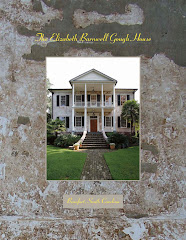
Antebellum accounts describe the tremendous feasts that Beaufort planters regularly hosted for each other. The tables groaning with food and libation were testimony to their wealth, sea island abundance and a friendly competition among the planters as they tried with each feast to outdo each other.
At one point when the celebrations threatened to exceed even the planters’ standards for acceptable proportions, the Agricultural Society stepped in to institute a fine of 50 cents to discourage members from serving more than six dishes of meat at a single gathering.9
In a Beaufort accustomed to lavish celebrations, three would be remembered for surpassing all others. And John Gibbes Barnwell was fortunate enough to live to see and participate in all three -- the visit of President James Monroe in 1819, the Fourth of July Celebration of the same year and the visit of the Marquis de Lafayette in 1825.
In 1819, President Monroe was enroute to inspect the new territories of East and West Florida, recently acquired through the Adams-Onis Treaty with Spain. After crossing the Whale Branch River on the Port Royal Ferry, Monroe was met by virtually all of Beaufort’s white, adult male population on horseback. The presidential party (which included Secretary of War John C. Calhoun and South Carolina Governor John Geddes) was escorted by the welcoming crowd the six miles to town.
The spontaneous parade most likely followed what is now Boundary and Carteret Streets, taking the fifth president of the United States directly by the Elizabeth Barnwell Gough House. It is easy to imagine the excitement generated by the procession and a not quite three-year- old John Gibbes Barnwell II and his older sisters watching from the grounds as it passed by.
The next day after an inspection tour of Fort Marion on Spanish Point, Monroe was given a banquet hosted by the “citizens of the College”10 which included John Gibbes Barnwell as a member of the Board. The evening was marked by numerous patriotic toasts and an outpouring of national and civic pride.
So great were the town’s emotions, they apparently could not be given full expression in one evening. So Beaufort was prompted to reprise the event two months later with the most memorable Fourth of July celebration in its history. Reportedly, a total of 31 toasts were made. With etiquette of the time dictating that an offered drink or toast was never refused, it is a wonder who among the celebrants was able to keep count. Unless it was John Gibbes Barnwell, for he is said to have found a singular way around the custom.
As the story goes on his wedding day, his friends offered him glass after glass of wine to celebrate, hoping to see John, who was known for moderation, for once inebriated. But much to their surprise, John continued to show no side effects, until it was discovered that he had been pouring the contents of each glass into his high cravat. He was soaked, but sober for his wedding.
The third high point for Beaufort, and certainly for John Gibbes Barnwell as well, was the visit of the Marquis de Lafayette in 1825. The town had declared the entire day a holiday in his honor. But weather and the tide delayed his arrival aboard the steamship SS Henry Shultz until 11:00 PM. Even his late arrival, though, could not deter the town from welcoming one of the most celebrated and beloved heroes of the American Revolution. Like Monroe, he was greeted by virtually the entire town. This time the town turned out with a spontaneous candlelight procession up Bay Street to a dress ball held in his honor.
9Theodore Rosengarten, Tombee, Portrait of a Cotton Planter, William Morrow and Company, Inc., New York, page 11
10The History of Beaufort County, South Carolina, page 291
Please note that the material in this blog is copyrighted. It is not to be reproduced without my specific written permission.
.jpg)
